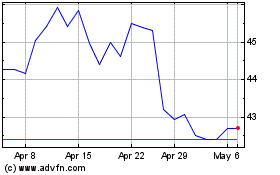BHP Billiton Returns to Profit, Raises Dividend
21 February 2017 - 5:12PM
Dow Jones News
By Rhiannon Hoyle
SYDNEY--Mining giant BHP Billiton Ltd. (BHP.AU) swung back to
profit in its fiscal first half, reflecting higher commodity
prices, continued cost cutting, and the absence of large writedowns
that had ravaged its bottom line a year earlier.
The improvement prompted the world's No. 1 miner by market value
to more than double its dividend, after only a year ago scrapping a
pledge to keep its payout steady or rising because of weak
markets.
Global miners have been benefiting from an upswing in commodity
prices that's enabled them to rebuild their balance sheets
following a deep multiyear downturn. Iron ore almost doubled in
value in 2016, and prices for natural resources including coal and
crude oil also rose.
BHP on Tuesday reported a net profit of US$3.20 billion for the
six months through December, which compared to a loss of US$5.67
billion in the same period a year earlier. The year-ago result was
linked to multiyear lows in commodity prices and roughly US$6
billion in one-off charges--mainly write downs against U.S. energy
assets.
Underlying profit increased to US$3.24 billion, from US$412
million a year earlier, it said. That prompted an increase in the
BHP's half-year payout to 40 U.S. cents a share, from 16 cents this
time last year. The miner earlier promised to offer shareholders at
least 50% of underlying profits each fiscal half.
"We are confident in the long-term outlook for our commodities,
particularly oil, with markets expected to rebalance in the
near-term, and copper where we expect a deficit to emerge in the
early 2020s," said Chief Executive Andrew Mackenzie. BHP recorded
its worst-ever annual loss last fiscal year.
Despite the upswing in world commodity markets, BHP said it
remains focused on improving the efficiency of its operations and
paying down debt, after building up a large pile of borrowings in
recent years as the company expanded sites churning out commodities
including iron ore and petroleum.
The miner said net debt fell 23% to US$20.06 billion at the end
of 2016. It said it is on track to meet a target for US$1.8 billion
in productivity gains this fiscal year, excluding any impact from
industrial action at its Escondida copper mine in Chile.
Last month the company reported mixed production results for the
period. It recorded a 7% decline in copper output, mostly linked to
disruptions to its remote Olympic Dam mine in South Australia
state. Petroleum production fell 15% after BHP deferred the
development of some onshore U.S. fields.
Still, output from its vast iron-ore operations-BHP is the
world's No. 3 iron ore exporter-was up 4% as the company increased
production from its newest iron-ore mine, Jimblebar, in Western
Australia.
BHP said substantial progress was being made on social and
environmental remediation programs at its Samarco iron-ore venture
in Brazil following a deadly dam spill in 2015. The collapse of a
dam built at the Samarco mine that it jointly owns with Vale SA
(VALE) released an avalanche of sludge that killed 19 people and
polluted more than 400 miles of rivers.
-Write to Rhiannon Hoyle at rhiannon.hoyle@wsj.com
(END) Dow Jones Newswires
February 21, 2017 00:57 ET (05:57 GMT)
Copyright (c) 2017 Dow Jones & Company, Inc.
BHP (ASX:BHP)
Historical Stock Chart
From Mar 2024 to Apr 2024

BHP (ASX:BHP)
Historical Stock Chart
From Apr 2023 to Apr 2024
